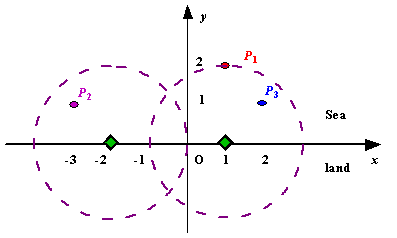Radar Installation
| Time Limit: 1000MS | Memory Limit: 10000K | |
| Total Submissions: 75260 | Accepted: 16841 |
Description
Assume the coasting is an infinite straight line. Land is in one side of coasting, sea in the other. Each small island is a point locating in the sea side. And any radar installation, locating on the coasting, can only cover d distance, so an island in the
sea can be covered by a radius installation, if the distance between them is at most d.
We use Cartesian coordinate system, defining the coasting is the x-axis. The sea side is above x-axis, and the land side below. Given the position of each island in the sea, and given the distance of the coverage of the radar installation, your task is to write a program to find the minimal number of radar installations to cover all the islands. Note that the position of an island is represented by its x-y coordinates.

Figure A Sample Input of Radar Installations
We use Cartesian coordinate system, defining the coasting is the x-axis. The sea side is above x-axis, and the land side below. Given the position of each island in the sea, and given the distance of the coverage of the radar installation, your task is to write a program to find the minimal number of radar installations to cover all the islands. Note that the position of an island is represented by its x-y coordinates.

Figure A Sample Input of Radar Installations
Input
The input consists of several test cases. The first line of each case contains two integers n (1<=n<=1000) and d, where n is the number of islands in the sea and d is the distance of coverage of the radar installation. This is followed by n lines each containing
two integers representing the coordinate of the position of each island. Then a blank line follows to separate the cases.
The input is terminated by a line containing pair of zeros
The input is terminated by a line containing pair of zeros
Output
For each test case output one line consisting of the test case number followed by the minimal number of radar installations needed. "-1" installation means no solution for that case.
Sample Input
3 2 1 2 -3 1 2 1 1 2 0 2 0 0
Sample Output
Case 1: 2
Case 2: 1
对于一个小岛,雷达放置在海岸线(即x轴)一个区域内都可以侦测到该岛,就管这个叫覆盖区域吧,求出每个岛的覆盖区域,
就转化成了若干个区间的交集,按左界升序排列,然后就是贪心的处理
#include<cstdio>
#include<cstring>
#include<cmath>
#include<algorithm>
using namespace std;
struct node{
double x, y;
}s[1010];
bool cmp(node a, node b){
return a.x < b.x;
}
int main(){
int n, kcase = 1;
double a, b, flag, d;
while(~scanf("%d%lf", &n, &d), n || d){
int ok = 0;
for(int i = 0; i < n; i++){
scanf("%lf%lf", &a, &b);
s[i].x = a - sqrt(d*d - b*b);//求覆盖区域
s[i].y = a + sqrt(d*d - b*b);
if(b > d || d < 0){
ok = 1;
}
}
if(ok){
printf("Case %d: -1\n", kcase++);
continue;
}
sort(s, s + n, cmp);
flag = s[0].y;
int ans = 1;
for(int i = 1; i < n; i++){
if(s[i].y <= flag){//右界为判断点,更新区域边界
flag = s[i].y;
continue;
}
if(s[i].x > flag){//当一个岛的左界已经不再上一个区域,就以这个岛的右界开启新的区域
ans++;
flag = s[i].y;
}
}
printf("Case %d: %d\n", kcase++, ans);
}
return 0;
}




 解决海岸线上雷达安装问题,确保所有岛屿被雷达覆盖,通过计算每个岛屿的覆盖区域并使用贪心算法找到最少的雷达数量。
解决海岸线上雷达安装问题,确保所有岛屿被雷达覆盖,通过计算每个岛屿的覆盖区域并使用贪心算法找到最少的雷达数量。
















 5995
5995

 被折叠的 条评论
为什么被折叠?
被折叠的 条评论
为什么被折叠?








